Currency Notes
Norway
Finance & Development, March 2015, Vol. 52, No. 1
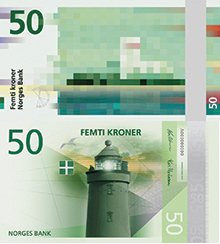
Design, Democracy, and Daring
Norway’s new banknotes won’t enter circulation until 2017 but they have already been described as the world’s coolest currency. What do the bold designs—and even the selection process—tell us about this Nordic nation?
Norway is on top of the world in more
ways than one. Geographically speaking,
its lands reach deep into the Arctic Circle, and the nation of 5 million is also at the pinnacle of the UN’s economic and societal rankings.
Monarchy and democracy
In December 2012, the Bank of Norway began the long process of launching new banknotes, citing the need to update anticounterfeiting features. In 2014, it launched a competition to find a design that would meet both security and aesthetic requirements.
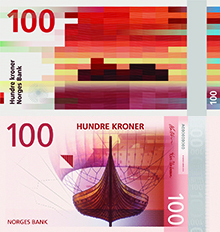
Working with jury members from various walks of life, the bank took the unusual step of choosing a combination of two proposals to take forward for production.
The front of the notes will be developed from design firm The Metric System’s “Norwegian Living Space” proposal and the reverse from Snøhetta Design’s “Beauty of Boundaries” submission. The blending of proposals addressing space and boundaries appears harmonious. And the fair, open competition process with more than one winner seems to reflect Norway’s reputation for democracy and inclusiveness.
Besides being a poster child for democracy, Norway is a constitutional monarchy, and the evolution of its banknotes traces a certain shift in its society’s focus. The first bills, in the late 19th century, all depicted the king. In recent decades, they have honored citizens prominent in the arts and sciences, such as the painter Edvard Munch. The Bank of Norway’s choice of theme for the new banknotes is the sea.
The sea
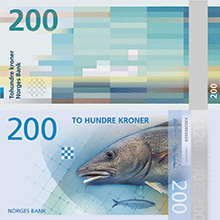
Norway’s unique coastline of fjords has always been more of a gateway than a border, and the sea has been the lifeblood of its economy and culture. Exploration was the business of the Vikings, who raided and traded across Europe (and beyond) from the late 8th to the late 11th centuries. Nowadays “exploration” is more often associated with the offshore oil industry. Petroleum accounts for about a quarter of the country’s gross domestic product. These benefits are shared. Oil revenue feeds into a huge sovereign wealth fund, used to serve the country as a whole.
These elements all come into play in the banknote design, with the chosen motifs looking both to Norway’s history and its future. One side will feature clearly recognizable designs, such as a Viking longboat on the 100 kroner note or fish on the 200 kroner note. The reverse will have striking pixelated images, “the language of our times,” according to the designers. These become increasingly stretched and abstract in higher denominations, an effect intended to evoke the wind. The blurring of borders is also explored with each banknote borrowing some color from the next in the sequence.
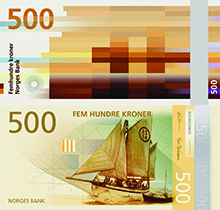
“We have chosen a theme we consider to be original and particularly relevant for Norway, which is a small country but a major coastal nation. Norway has a total coastline of 83,000 km, the longest in Europe. The use of marine resources, combined with the use of the sea as a transport artery, has been crucial to the development of Norway’s economy and society.”
—Trond Eklund, Director of Norges Bank’s Cashier’s Department
Design and innovation
Norway’s future banknotes have won plaudits across the world for their bold aesthetics.
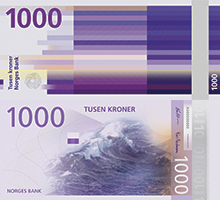
But design and the drive to innovate in the Nordic region have always been firmly rooted in function. If necessity is the mother of invention then it is no surprise that the Old Norse people devised brilliant solutions to manage cold, dark winters and venture beyond their lands. The Vikings carved out an advantage in trade and warfare with ships and seafaring that were advanced for their time.
A thousand years ago Vikings were buried in boats and with coins in the belief that they would take them to the afterlife. But they also left a great wealth behind, a disposition toward resourcefulness, innovation, and adventure that stands Norway in good stead today. This spirit is well captured in its bold and forward-looking banknotes. ■


